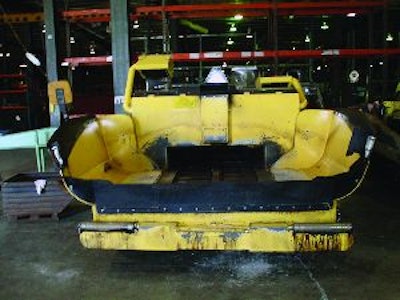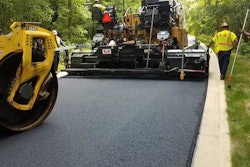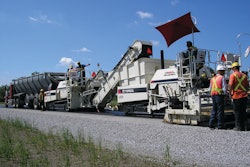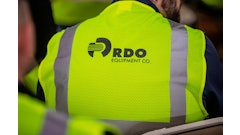
An asphalt paver is really three systems in one. A tractor powers the paver, a material handling system moves hot mix from the hopper to the screed, and the screed "levels and profiles" the material. How this all gets done varies from one manufacturer to another, with the goal being to provide a smooth, homogenous mat out the back end of the paver.
The Asphalt Institute's Asphalt Handbook describes the screed as "the most important component of the asphalt paver" and with good reason. The screed provides an initial placement, finish, and compaction to the hot mix asphalt. But getting the hot mix asphalt properly and efficiently to the screed might be the most important job of the paver.
"The head of material is probably the most important thing for a paving crew, to keep that consistent," says Larry Spring, road machinery product specialist for Volvo. "As the head of material goes down, the screed goes down and the mat becomes thinner. If the head of material goes up, the screed goes up and the mat becomes thicker. The key is to keep the head consistent because that keeps the mat thickness consistent."
So here's an insight into a paver's material handling system, how it does what it does, and how that affects what the screed can do for a contractor.
Hopper
Starting at the front, where the haul truck meets the paver, there are the hopper and the hopper aprons.
"The capacity of the hopper will affect the types and sizes of jobs the contractor can complete with that paver," Spring says. "The volume of the hopper will impact the type of work - or looking at it the other way around, the type of work will dictate the hopper volume the contractor needs."
Bomag America's John Hood says that hopper size is less important on a mainline paver which paves long straight pulls because the hopper can be continually fed by haul trucks in a paving train. But on a commercial job where few pulls are long and much paving is done in tight areas, hopper size is extremely important.
"In those situations you want a large hopper so you can fill it up, back it into an area, and then pave your way out to engage the haul truck again," Hood says. "In the commercial application it is truly the larger the better."
Related to the hopper is the apron, which is in front of the hopper between the hopper and the haul truck. The hopper apron prevents hot mix dumped from the truck from falling onto the pavement. This is not only a waste of material but it creates additional work for laborers, so the apron is an important element of the hopper.
Hood adds that manufacturers are always working on the hopper wings as well, redesigning them to make mix flow more smoothly into and through the hopper without sticking. But he says whether the wings are squared, angular or rounded (the current trend) none seem to make the mix flow through any more smoothly.
Conveyors
Once dumped into the hopper, the mix must be moved to the screed. It's important to move the mix quickly so it maintains its heat and evenly so a consistent head of material is brought to the screed. The material also must be moved in bulk to avoid segregation (where material fines separate from medium and larger chunks of aggregate).
Pavers get this done through the use of conveyors. Most manufacturers rely on dual conveyors, each of which feeds an auger on one side of the machine. Conveyors use slats of steel that look like thin metal bars. These bars are evenly spaced and both ends of each bar are connected to parallel chains. The bars are raised and essentially bite into the bottom of the mix in the hopper, pulling it from the hopper toward the augers and screed.
Hood says the hopper and the conveyors are closely linked. The conveyors move material from the bottom of the hopper, and paddles or noncontact sensors automate the conveyor to keep material moving steadily to the screed. In some pavers paddles inside the top rear of the hopper turn the conveyor on or off; in other units paddles are located on the conveyor itself.
Whether mounted in the hopper or on the conveyor the paddles work in essentially the same way. When material pushes against the paddle it shuts the conveyor or auger off. When material does not push against the paddle the conveyor or auger operates until material pushes against the paddles again and the system turns off.
Other pavers offer noncontact conveyor sensors to slow or stop the conveyor. Sensors are adjustable and when material coming through the conveyor reaches a predetermined height the sensor slows and stops the conveyor. "When the height of material falls, the sensor conveyors are turned on to keep that predetermined height of material," Spring says.
At least one manufacturer has moved away from slat conveyors, opting instead for screw conveyors. These are mounted lengthwise and rely on the rotating screw motion of an auger to do the same job as slat conveyors.
Auger assembly
The conveyor moves the hot mix asphalt from the hopper to the auger assembly. The augers, which operate perpendicular to the conveyor, look a little like threads on a screw. As the augers turn they pick up mix in their "threads" and carry it from the conveyor to either the left or the right side of the rear of the paver.
"The biggest problem is keeping an even, steady head of material from the conveyor to the auger to the screed," Spring says. "Augers should run slow and continuously and should not be constantly sped up or slowed down to maintain the head of material at the screed."
Spring recommends relying on automatic sensors as opposed to making manual adjustments if the paver has automatic sensors. "When using manual sensors people tend to overfeed the material and then let it run down too low so there's very little material; then they crank it back up again to get it where it should be; then they back off and let it fall down. And with a free-floating screed, as the head of material changes the depth of the mat changes."
In addition to the augers pavers offer auger extensions which enable the contractor to pave widths wider than the width of the paver. Hood says that on many highway class pavers the auger extensions are bolted on and mix is pushed from the auger into the extension and then forced to the edge of the extension by the other mix in the auger. Hood says this approach works well for roadway paving where the pulls are long and there are no obstructions that might cause an operator to narrow the width of his paving.
"On commercial jobs, however, bolt-on auger extensions can be impractical because paving passes are affected by islands, light poles, and other obstacles," Hood says. "So commercial pavers offer extensions connected to the screed so as the screed extends or is retracted the auger extensions move with it."















![Lee Boy Facility 2025 17 Use[16]](https://img.forconstructionpros.com/mindful/acbm/workspaces/default/uploads/2025/09/leeboy-facility-2025-17-use16.AbONDzEzbV.jpg?ar=16%3A9&auto=format%2Ccompress&fit=crop&h=135&q=70&w=240)




